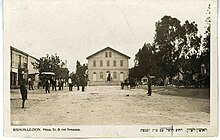
Back Jischuw ALS يشوف Arabic যিশুভ Bengali/Bangla Yixuv Catalan Jišuv Czech Yishuv Welsh Yishuv Danish Jischuv German Jiŝuv Esperanto Yishuv Spanish
This article has multiple issues. Please help improve it or discuss these issues on the talk page. (Learn how and when to remove these messages)
|
ישוב | |
|---|---|
 Jewish yishuv in Rishon Lezion, 1882 | |
| Total population | |
| 1880s | 25,000 |
| 1948 | 630,000 |
| Regions with significant populations | |
| Palestine (Ottoman Syria, OETA South, Mandatory Palestine) | |
| Languages | |
| Hebrew, Ladino, Judeo-Arabic, Yiddish | |
| Religion | |
| Judaism | |
| Related ethnic groups | |
| Old Yishuv, New Yishuv | |
The Yishuv (Hebrew: ישוב, lit. 'settlement'), HaYishuv HaIvri (Hebrew: הישוב העברי, lit. 'the Hebrew settlement'), or HaYishuv HaYehudi Be'Eretz Yisra'el (lit. 'the Jewish Settlement in the Land of Israel') was the community of Jews residing in Palestine prior to the establishment of the State of Israel in 1948. The term came into use in the 1880s, when there were about 25,000 Jews living in that region, and continued to be used until 1948, by which time there were some 630,000 Jews there.[1] The term is still in use to denote the pre-1948 Jewish residents in Palestine, corresponding to the southern part of Ottoman Syria until 1918, OETA South in 1917–1920, and Mandatory Palestine in 1920–1948.[2]
A distinction is sometimes drawn between the Old Yishuv and the New Yishuv. The Old Yishuv refers to all the Jews living in Palestine before the first Zionist immigration wave (aliyah) of 1882, and to their descendants until 1948. The Old Yishuv residents were religious Jews, living mainly in Jerusalem, Safed, Tiberias, and Hebron. There were smaller communities in Jaffa, Haifa, Peki'in, Acre, Nablus, Shfaram, and until 1799[3] in Gaza. In the final centuries before modern Zionism,[clarification needed] a large part of the Old Yishuv spent their time studying the Torah and lived off charity (halukka), donated by Jews in the Diaspora.[4][clarification needed]
The term New Yishuv refers to those who adopted a new approach, based on economic independence and various national ideologies, rather than strictly religious reasons for settling in the "Holy Land".[citation needed] The precursors began building homes outside the Old City walls of Jerusalem in the 1860s, followed soon after by the founders of the moshava of Petah Tikva, with growth in full swing during the First Aliyah of 1882, followed by the founding of neighbourhoods and villages until the establishment of the State of Israel in 1948.[citation needed]
- ^ Eliezer Ben-Rafael and Stephen Sharo, Ethnicity, Religion and Class in Israeli Society, Cambridge University Press, pages 26–27.
- ^ Tripathi, Deepak (2013). Imperial Designs: War, Humiliation & the Making of History. Potomac Books. ISBN 978-1-61234-624-3. Retrieved 10 January 2021.
- ^ Benayahu, M. (1956). "לתולדות היישוב היהודי בעזה (מסוף המאה הי"ז ועד שנת תרפ"ט)" [On the History of the Jewish Settlement in Gaza]. Bulletin of the Israel Exploration Society (in Hebrew). 20 (1–2): 21–30. JSTOR 23729416.
- ^ From Empire To Empire: Jerusalem Between Ottoman and British Rule, Abigail Jacobson, Syracuse University Press, page 51